Table of Contents
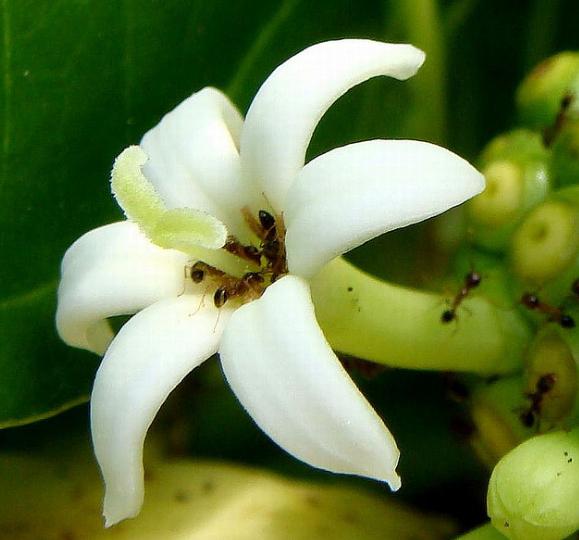
Fig. 1. Flower of Morinda citrifolia. (Photo: Rana Pipiens)
Learning the truth about Noni!
If you are a fan of the Noni Juice, are you aware that the ripe fruits of Noni (Morinda citrifolia) smell like vomit? Most insects are killed instantaneously upon eating the ripe fruits of Noni! Do you know that the grenade-like structure (Fig. 2) isnot a fruit but consist of many fruits fused together?
Read further and find out how scientists work like detectives in unravelling the mysteries of this supposedly well-known plant! While biomedical scientists expose unfounded claims of this "miracle plant", evolutionary biologists investigate the evolution of a fly species unique ability to feed on the toxic fruits. Phylogenetics turns out to be significant in the detective tool kit in not only resolving its classification but has also enabled systematists to trace its highly debated geographic origin and investigate if its multiple fruit is an ancestral or derived trait. Finally, taxonomists struggle over the nomenclature of Morinda citrifolia as the type specimen actually represents another Morinda species.
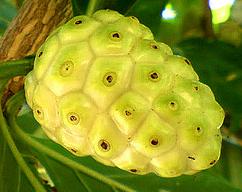
Fig. 2. Multiple fruit of Morinda citrifolia (Photo: Cappuccino Commotion).
Are Noni products safe and effective?
Noni has a long history of use as a traditional remedy for many ailments in Polynesia and Southeast Asia [1]. This has promoted the use of Noni as a dietary supplement in the form of juice, tablets or tea (Fig. 3) which are easily available from grocery stores and the Internet [2]. Its popularity is not surprising since it is marketed as a remedy for several chronic diseases such as cancer and diabetes [3]. However, it is appalling that some websites have provided unfounded claims of the beneficial effects of "Xeronine" in Noni e.g., Video1. The claims that "Xeronine" is able to rejuvenate cells can be traced back to a publication in the Pacific Tropical Botanical Garden Bulletin [4]. One should be suspicious if a biochemistry finding is published in a botanical journal as it may be rejected by a biochemistry journal. Some scientists have even criticized that “it may been better published in the Journal of Irreproducible Results” [5]! Both the presence of "Xeronine" in Noni and its chemical structure have not been published in a peer-reviewed biochemistry journal [2][5].
| Vid. 1. "Xeronine", a molecule unheard of in the biomedical literature! |
Fig. 3. Noni effervescent (Image: Junhao). |
Studies have suggested anti-cancer activity of polysaccharides in Noni when injected into mice [6][7] but it is unknown if such effects remain when ingested in humans [2]. Clinical trial is vital in the detective tool kit of biomedical scientists and it is the gold standard used in conventional medicine to assess safety and effectiveness. A clinical trial at The National Center for Complementary and Alternative Medicine is still incomplete [8]. Presently, no Noni products have sufficient scientific evidence to be used as medicine [8]. Nonetheless, a safety review indicated that Noni is generally safe for consumption in healthy adults [9]. Pregnant and lactating ladies should avoid Noni as it is historically used for abortion and little is known about its effects on breastfeeding [8]. Noni should also be avoided in patients with liver or kidney disease as there are reports of hepatotoxicity [10][11] and hyperkalemia [12] in patients who drank Noni juice. While Noni may be a promising source of botanical drug, one must bear in mind that natural products are not necessarily safe and ancient knowledge is not absolutely reliable.
Is the Noni fruit toxic to insects?
Although some humans consume Noni juice as a tonic drink, most insects are killed instantaneously upon eating the ripe fruits of Noni [13]! For example, most fruit flies avoid the ripe fruits due to the presence of several toxic compounds e.g., octanoic acid [14]. Nonetheless, one particular species of fly, Drosophila sechellia (Fig. 4), is not only resistant to the toxicity of Noni [15] but also exclusively uses the ripe fruits of Noni as a breeding site [16].
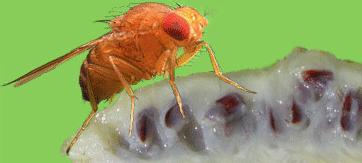
Fig. 4. Drosophila sechellia (Image: Prof Jones).
To investigate this intriguing phenomenon, neurogenetics and comparative genomics [17] became crucial detective tools for evolutionary biologists. While it is intuitive to deduce that the ability to feed on the ripe fruits of Noni is due to a gain in novel gene functions, the detective work suggested otherwise. It turns out that several genes involved in olfaction and metabolism are downregulated in D. sechellia compared to its close relatives [18]. D. sechellia has lost several bitter-taste receptor genes that are needed to perceive the toxic chemicals in Noni [19]. Besides, the knockdown of odour perception genes in a close relative, D. melanogaster, caused them to be less averse to the ripe fruits of Noni [18]. This suggests that host specialisation in D. sechellia may not attained by the gain of new abilities but rather by the loss of pre-existing abilities [17].
Where is the geographic origin of Noni?
The geographic origin of M. citrifolia is highly debated. Until recently, most scientists believe that the plant originated from Southeast Asia (SEA) and spread to the rest of the tropics (Fig. 5) by oceanic currents and/or domestication [20]. It was thought that the Southeast Asian ancestors of the Micronesian and Polynesian people brought along Noni fruits during their migration [20][21][22]. Others argued that M. citrifolia originated from India. They insisted that Noni’s medicinal properties have been documented in the ancient Aryan literature long before the Southeast Asians, Polynesians or Micronesians knew about its existence [23]. Systematists took a different approach to resolving this conflict. By putting phylogenetic trees onto maps, systematists are able to trace the biogeographic history of various Morinda taxa. Nonetheless, this is not a simple puzzle as two phylogenetic analyses by different systematists revealed different trees.

Fig.5. The grey area represents the current geographical distribution of M. citrifolia (Razafimandimbison et al. (2010), reproduced with permission).
.
Based on the phylogenetic tree by a Morinda expert [24], an ethnobotanist suggested an Australian origin of M. citrifolia [25]. This is because M. citrifolia is the sister species of the Australian M. reticulata. It turns out that the phylogenetic tree is flawed as the outgroup consists of M. grayi and M. myrtifolia that are later discovered to have diverged more recently than the ingroup taxa [26]. This is tantamount to selecting the more recently evolved mammals as the outgroup for a phylogenetic analysis of amphibians. The outgroup should be ancestral to, but closely related to the ingroup. The second phylogenetic analysis with a proper outgroup indicated a Micronesian origin of M. citrifolia [27]. M. citrifolia exist in three varieties that can be thought of as geographical races (Fig. 6, red box). The tree revealed that M. citrifolia (Fig. 6, red box) is more closely related to the Micronesian endemics (Fig. 6, blue boxes) than to the Southeast Asian taxa (Fig. 6, green box). However, the debate persists as the Indian scientists maintained that Noni originated from India by digging up ancient Sanskrit writings and claiming that the Micronesian endemics are also found wild in India [23].
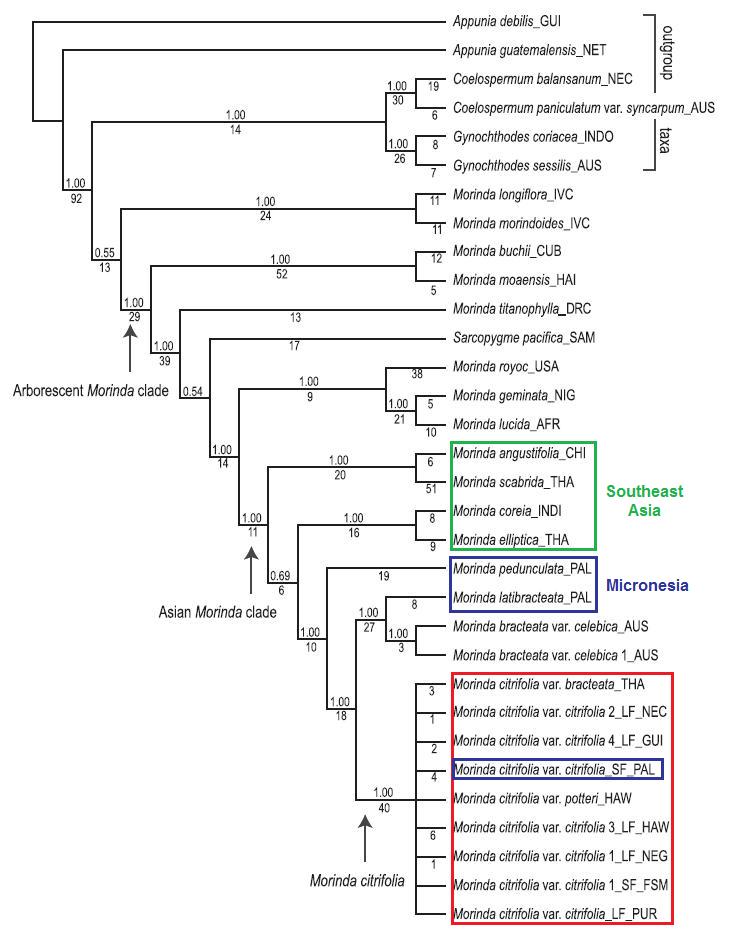
Fig. 6. Bayesian majority rule consensus tree of the Morindeae based on nrETS, nrITS, rps16 and trnT-F data from 22 taxa. Values above the nodes are posterior probabilities and those below are numbers of evolutionary steps. For more details, see the original publication Online PDF (Razafimandimbison et al. (2010), reproduced with permission).
Is Noni native to Singapore? Several accounts state that Noni was probably introduced from the Moluccas [28][29][30]. Besides, Noni is not listed in both editions of the Singapore Red Data Book [31][32]. Surprisingly, a recent checklist of the total vascular flora of Singapore indicates that Noni is nationally extinct [33], insinuating that Noni is native to Singapore! It turns out that this is an error (K.Y. Chong, pers. com.) and a correction is reflected in the first author’s website which states that Noni is cryptogenic (species of unknown origin). Besides, the online database of the Singapore Botanic Gardens Herbarium (SING) indicates that specimens of Noni have been collected only after 1992 (Fig. 7). It is likely that Noni has already become naturalized by then. When I did some detective work at SING, I managed to dig out some ancient specimens of Noni collected before 1992. Some of them were collected in the Southern islands while in other cases, the locality is either not recorded or sheds little light on whether the specimen was wild or cultivated (Fig. 8). Today, Noni can be found in secondary forests, back mangroves, in private gardens, and even along roadside verges in SIngapore.
| Acession No. |
Collector |
Collector's No. |
Date |
Locality |
| 37452 |
Turner, I.M. |
NSR669 |
30/4/1992 |
Sector 17, C22 R28 |
| 43353 |
Gwee, A.T. |
GAT238 |
10/2/2003 |
Pulau Ubin, Chek Jawa |
| 44630 |
Samsuri, A. |
KJ20 |
5/20/2003 |
Kranji, Sungei Pang Sua |
| 59401 |
Ganesan, S.K. |
SKG95 |
24/2/2005 |
Changi Air Base |
| 153608 |
Lua, H.K. |
SING2010-872 |
25/10/2010 |
Coney Island |
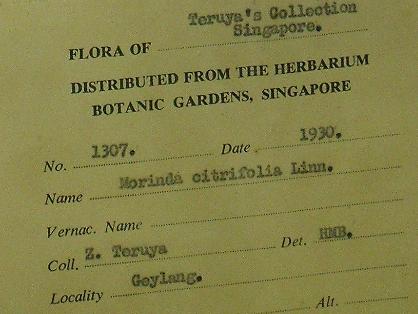
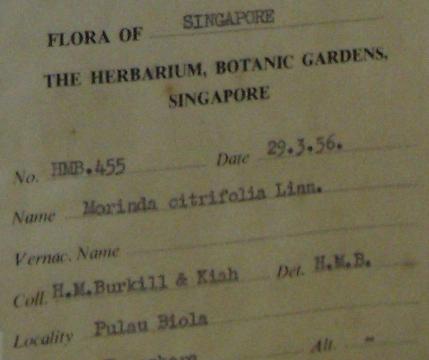
Fig. 8. Herbarium specimen labels of some M. citrifolia specimens collected before 1992 (Photo: Junhao). Note the year and locality on the labels.
How did Noni colonize the tropics?
Regardless of its origin, what has enabled the species to attain such a widespread distribution (Fig. 5) today? A British botanist noticed that the fruits decay rapidly when they fall into the sea but the pyrenes could float in water (Fig. 9) for many months [34]. A pyrene is a stony endocarp fused to a seed. He followed this promising lead and discovered an air sac within each pyrene (Fig. 10). This inspired further detective work on seed anatomy that unveiled tiny pits in the cells of the seed testa which facilitates buoyancy [35]. Hence, natural dispersal by water, coupled with its ability to self-pollinate and bear flowers and fruits throughout the year, have enabled its successful colonisation throughout the tropics [27].
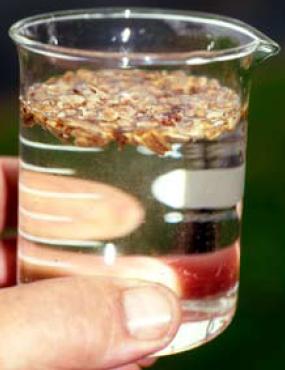 |
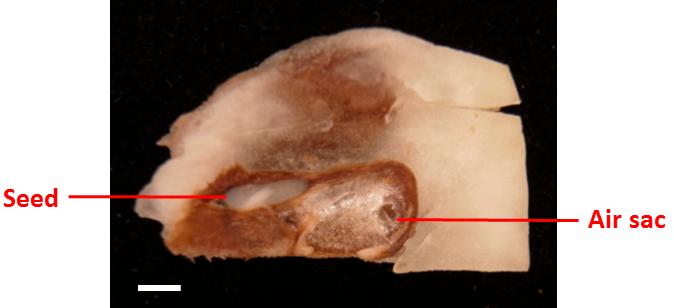 Fig. 10. Cross-section of a Noni pyrene. Scale bar = 20 mm (Photo: Junhao). |
Is multiple fruit an ancestral or derived trait?
Recall that the grenade-like structure of M. citrifolia (Fig. 2) is not a fruit but consist of several fruits fused together into a multiple fruit or syncarp. Pineapples and Jackfruits produce multiple fruit too. An ethnobotanist hypothesized that the multiple fruit of M. citrifolia evolved from an ancestor with simple fruits (Fig. 11) by the “fusion of ovaries of adjacent flowers and supression of pedicels” [25]. However, this hypothesis is no longer tenable in light of a recent phylogenetic analysis [36].
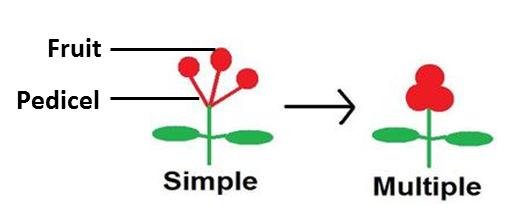
Fig. 11. Hypothetical evolution of multiple fruit from simple fruit (Image: Junhao).
Phylogenetics is important in the detective tool kit as it has several uses apart from classification. We just saw how it could evaluate past changes in the distribution of Morinda taxa. Besides, phylogenetics could also test the ethnobotanist’s hypothesis that the multiple fruit is a derived (apomorphic) trait within the Morindeae. The technique used is known as ancestral state reconstruction which computes the maximum probability of a character state on each ancestral node using a model of evolution [37]. This analysis has rejected the ethnobotanist’s hypothesis and revealed that the multiple fruit of M. citrifolia is an ancestral trait within the Morindeae [36].
Is Morinda citrifolia the correct name?
Any research would go down the drain if the basic nomenclature of a species is unclear. Taxonomists often work like detectives in getting the basic naming and classification right. This may require visiting different herbaria, deciphering ancient literature in various languages, and matching dates of protologues (original description of species) to dates of expeditions. This exposed a shocking error in the naming of M. citrifolia.
In the early days of botany, type specimens are often paintings by botanical artists (Fig. 12, left) as dried plants were difficult to preserve and transport back then. It turns out that Linnaeus's protologue of M. citrifolia refers to two illustrations, one of them is the less well-known M. coreia (Fig. 12, middle), and the other is the species known as M. citrifolia today [38]. A holotype was not designated. A holotype is the single specimen or illustration selected by the author at the time of publication and is the specimen that taxonomists should refer to for the verification of identity and nomenclature [37]. When a holotype is not designated, taxonomists have to select another specimen or illustration listed in the protologue as the lectotype. Unfortunately, a taxonomist erroneously selected the illustration of the species presently known as M. coreia as the lectotype [39]. If the botanical code is followed strictly,“the name M. citrifolia would have to apply to the species presently known as M. coreia and the species currently known as M. citrifolia would have to be called M. nodosa Buch. Ham.” [38]. This would lead to great confusion as Noni is widely cultivated for commercial uses [40].
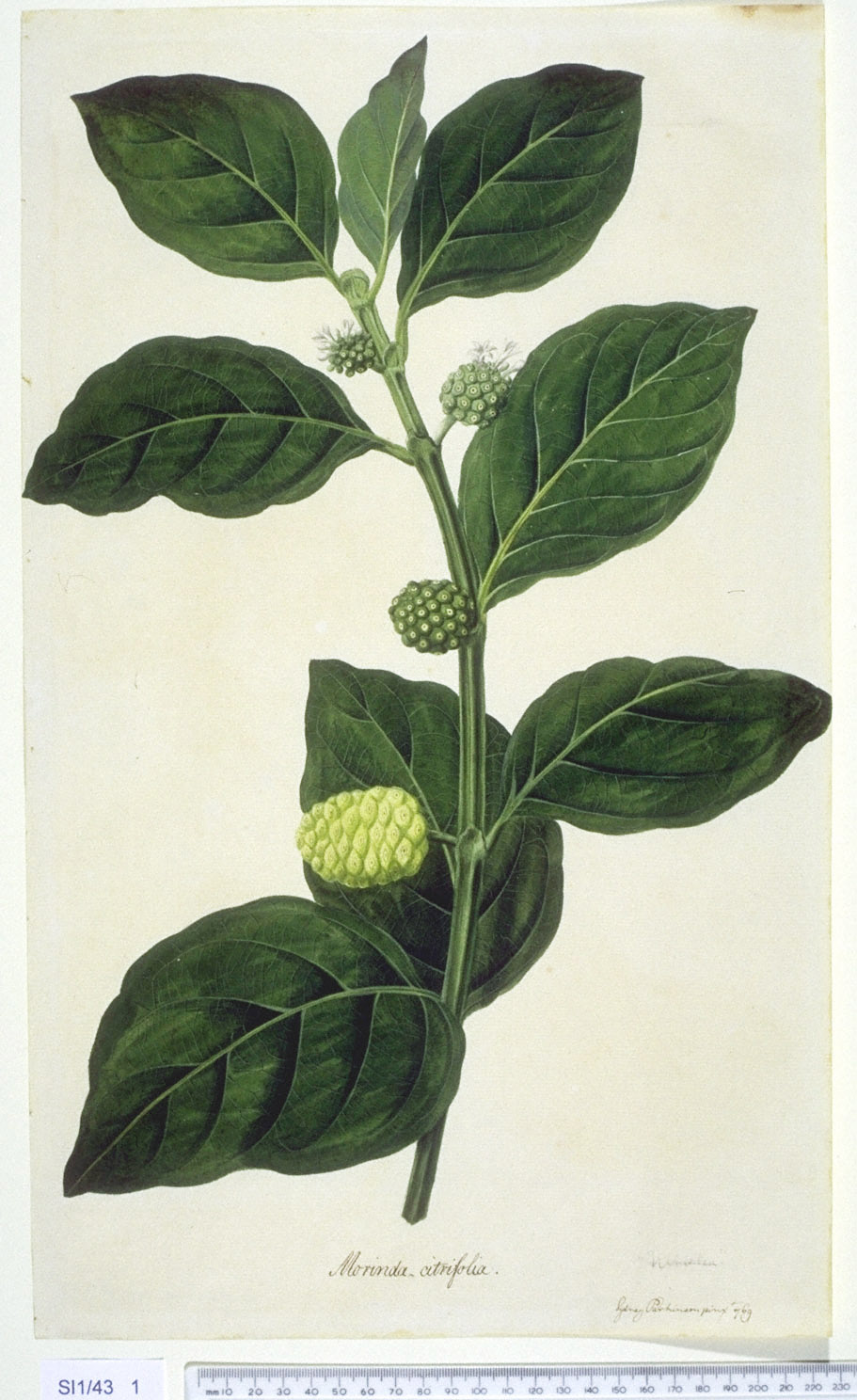 |
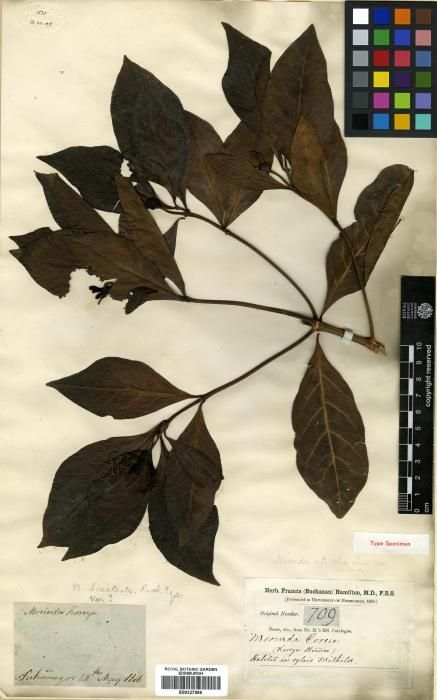 |
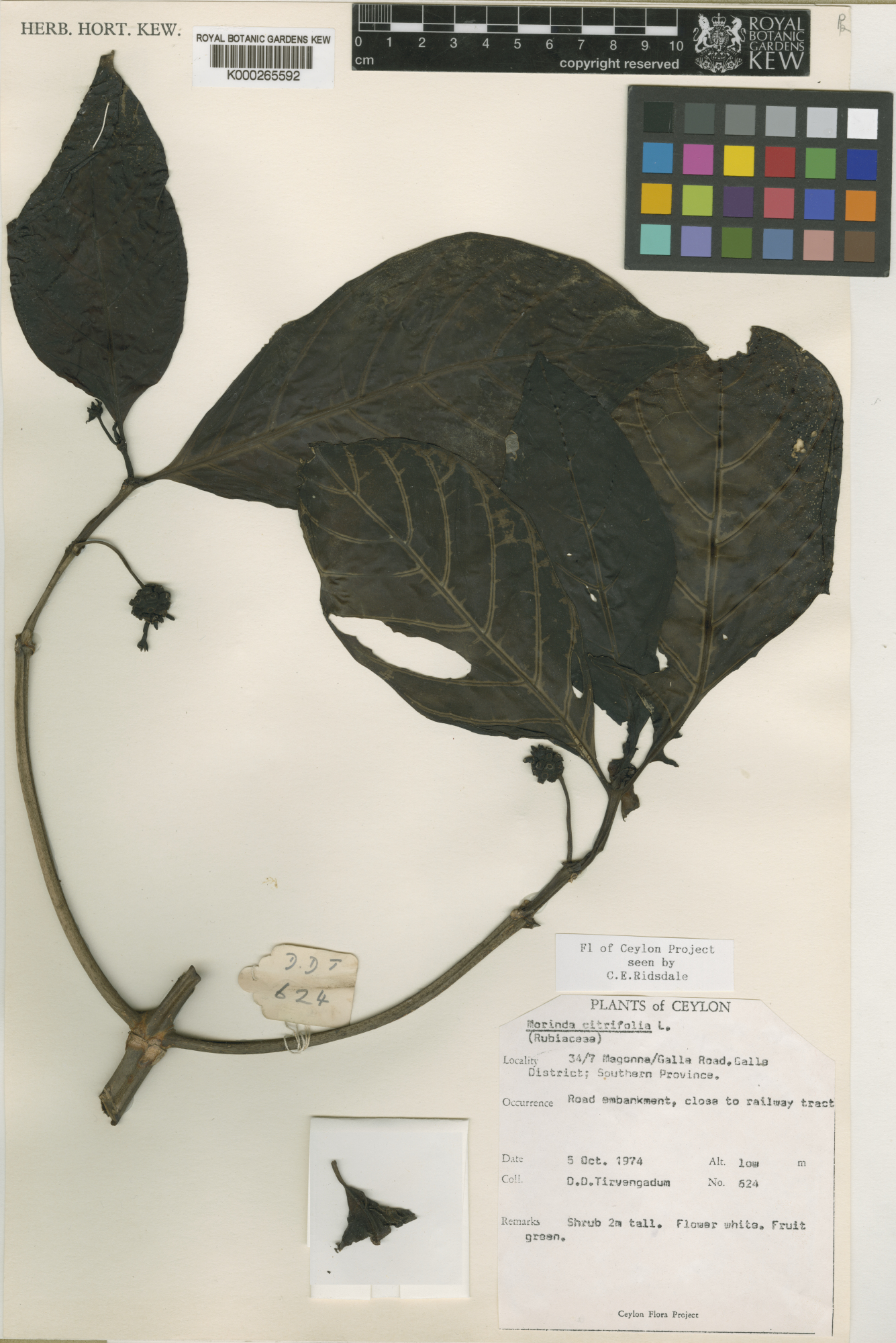 |
| Fig. 12. From left to right, Botanical illustration of M. citrifolia (Image: Natural history museum, London), specimen of M. coreia (Image: Royal Botanic Garden, Edinburgh), and conserved type of M. citrifolia (Image: Royal Botanic Gardens, Kew). Note that the left and middle images are not the actual illustrations stated in Linnaeus's protologue. |
||
Although nomenclature should not be regarded as science, it is still vital as species names are information retrieval and filing units. If the scientific name of Noni is changed, the older literature on Noni would be filed under M. citrifolia but the recent literature would be filed under the new name, M. nodosa. If a biomedical scientist discover that Noni juice could cause herb-drug interaction when taken with Paracetamol, and this information is filed under the new name, then this information is inaccessible to people who are unaware of the name change. Fortunately, taxonomists have proposed the conservation of the name Morinda citrifolia and designated Tirvengadum 624 (Fig. 12, right) from Sri Lanka as the conserved type [38]. This proposal has recently been approved by the nomenclatural committee [41].
Nomenclature
Etymology:
The genus name is derived from two latin words Morus, for the resemblance of the Noni’s multiple fruit (Fig. 13) to the true Mulberry (Morus alba), and indicus, meaning “of India”. The specific epithet, citrifolia, refers to resemblance of Noni's leaves to that of some citrus species.
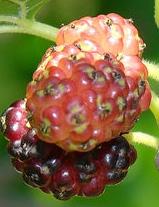 |
|
| Fig. 13. True Mulberry (Photo: Valter Jacinto) versus Noni (Photo: Junhao). |
|
Synonyms:
Morinda aspera Wight & Arn.; Morinda chachuca Buch.-Ham.; Morinda chrysorhiza (Thonn.) DC.; Morinda citrifolia var. bracteata (Roxb.) Kurz; Morinda citrifolia var. bracteata (Roxb.) Hook. f.; Morinda coreia var. stenophylla (Spreng.) Chandrab.; Morinda elliptica (Hook.f.) Ridl.; Morinda ligulata Blanco; Morinda littoralis Blanco; Morinda macrophylla Desf.; Morinda mudia Buch.-Ham.; Morinda multiflora Roxb.; Morinda nodosa Buch.-Ham.; Morinda quadrangularis G.Don; Morinda stenophylla Spreng.; Morinda teysmanniana Miq.; Morinda tinctoria Noronha; Morinda tinctoria var. aspera (Wight & Arn.) Hook.f.; Morinda tinctoria var. multiflora (Roxb.) Hook.f.; Morinda tomentosa B.Heyne ex Roth; Morinda zollingeriana Miq.; Platanocephalus orientalis Crantz; Psychotria chrysorhiza Thonn.; Samama citrifolia (L.) Kuntze; Sarcocephalus leichhardtii F.Muell. For more details, refer to The Plant List.
Vernacular names:
Commonly used ones include Canary wood, Cheese fruit, Great Morinda, Indian Mulberry, mengkudu, Noni, and Vomit fruit. For an entire list of vernacular names and the country in which they are used, see [20].
Type specimen:
The conserved type of M. citrifolia, Tirvengadum 624 (Fig. 12, right), is stored in the Royal Botanic Gardens, Kew. Flowers and immature fruits are present [38].
Scientific classification
Viridiplantae
........ Embryophyta
................ Tracheophyta
........................ Magnoliophyta
................................. Gentianales
.......................................... Rubiaceae
..................................................... Rubioideae
............................................................ Morindeae
.................................................................... Morinda
.......................................................................... Morinda citrifolia L.
The phylogeny of Morindeae was reconstructed using combined chloroplast and nuclear DNA sequence data [26]. It turns out that M. citrifolia (Fig. 14, blue box) as currently circumscribed is "monophyletic only if M. bracteata var. celebica (green box), presently delimited as M. citrifolia var. bracteata is excluded" [26]. Notice also that the genus Morinda is highly paraphyletic as Morinda taxa are nested in the Morinda clade, Coelospermum clade, as well as the Gynochthodes-Morinda clade (Fig. 14). Thus, systematists have employed a broader delimitation of Gynochthodes and a narrower delimitation of Morinda, resulting in a total of 78 new combinations [42].
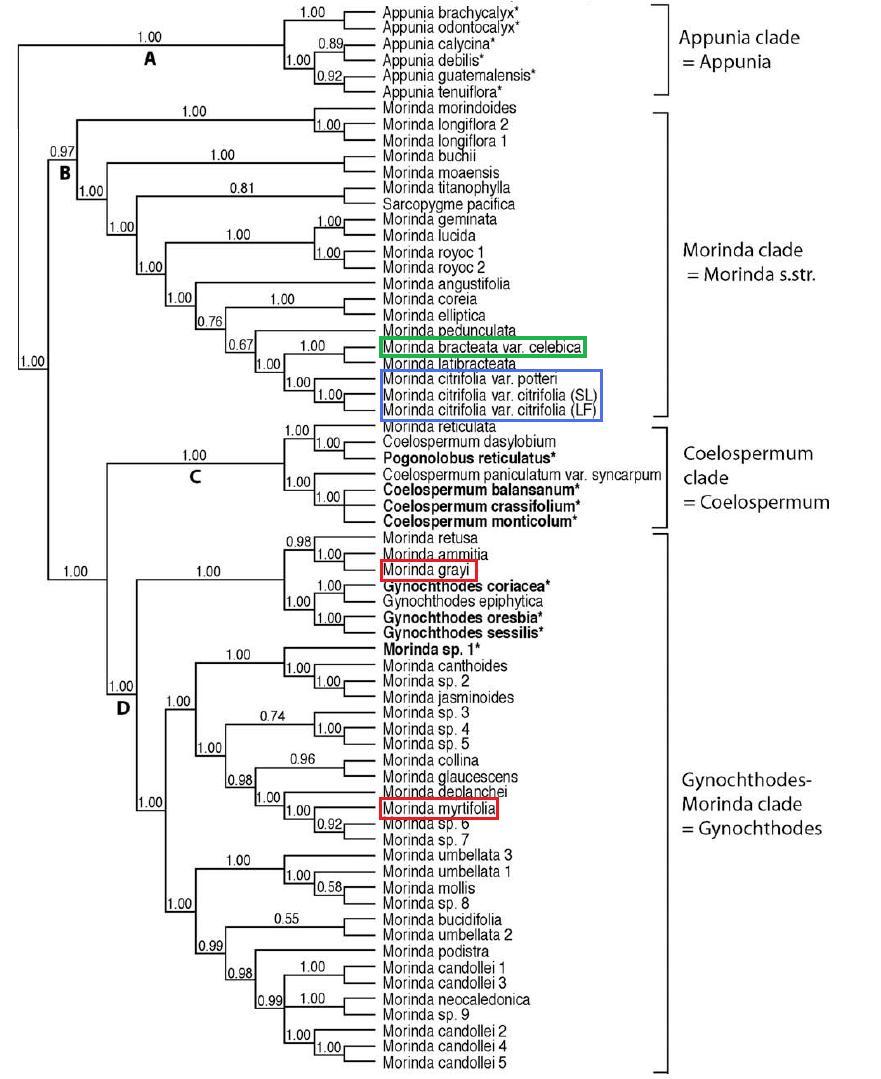
Fig. 14. Phylogeny of Morindeae. Baysian majority rule consensus tree from the combined nrETS/nrITS/trnT-F data of 67 Morindeae taxa. Values above the nodes are posterior probabilities. For more details, see Razafimandimbison et al. (2009).
In the discussion of the geographic origin of M. citrifolia, recall that a Morinda expert has constructed a phylogenetic tree that was flawed due to inappropriate choice of outgroup. His outgroup taxa include M. grayi and M. myrtifolia (Fig. 14, red boxes) which have diverged more recently than his ingroup taxa. His ingroup taxa are nested in the phylogentically basal Morinda clade. This mistake was made due to a lack of a robust phylogeny of the Rubiaceae and Morindeae during his research.
Description
Habit [24][43][44][45]
M. citrifolia grows as a tree up to 12 m (Fig. 15). The branches exhibit sympodial growth, flowering after every 2 nodes. This means that each branch consist of repeating units known as modules consisting of 2 internodes, a pair of leaves on one node, and a terminal inflorescence and a solitary leaf on another node (Fig. 16). The next module originates from the axil of the solitary leaf (Fig. 17).
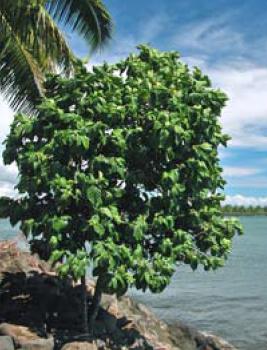
Fig. 15. From left to right, Woody habit of a cultivated M. citrifolia (Photo: Junhao) and a wild M. citrifolia (Nelson, 2006).
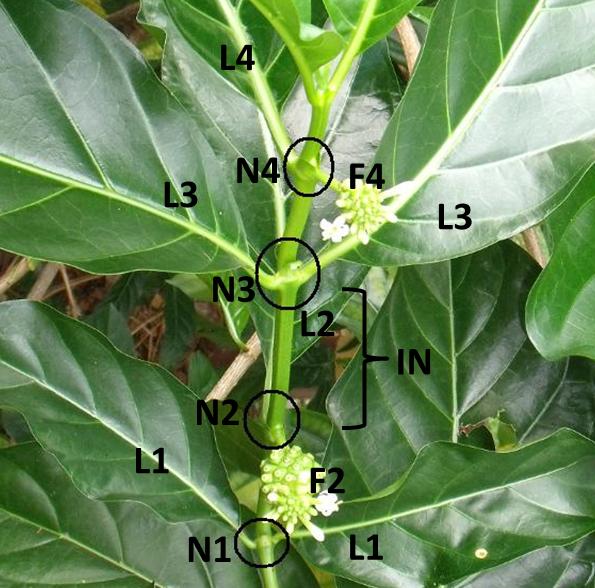 |
Fig. 16. Branch architecture of M. citrifolia (Photo: Junhao). A node is a point on the stem where leaves, inflorescences, or fruits are attached. This branch consists of 4 nodes (N1–N4). A pair of leaves (L1) is attached to the most basal node, N1. The node above it, N2, consists of a solitary leaf (L2) and a terminal inflorescence (F2). The part of the stem between 2 nodes is known as the internode (IN). N1, N2 and 2 internodes make up a module. N3 repeats the pattern of N1 while N4 repeats the pattern of N2. See the simplified diagrammatic version of the branch architecture in Fig. 17 below. |
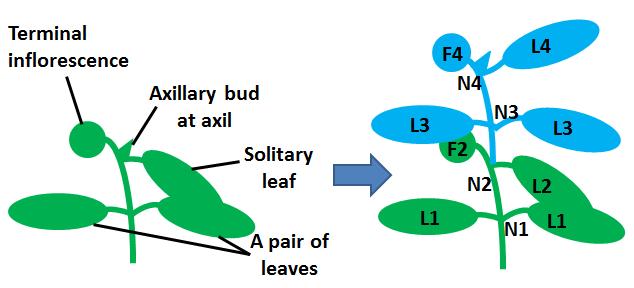 |
Fig. 17. Sympodial growth of the branches of M. citrifolia (Image: Junhao). An axil is the angle between the leaf stalk and the stem. The axillary bud is an embryonic shoot in the axil while the terminal bud occurs at the stem tip. The terminal inflorescence (F2) develops from the terminal bud while the next module (blue) develops from the axillary bud in the axil of the solitary leaf (L2). This mode of growth in which the apical meristem (terminal bud) is terminated e.g., as an inflorescence, while the lateral meristem (axillary bud) continues growing is known as sympodial growth. |
Leaves [24][44][46]
The leaves of M. citrifolia are oppositely arranged (Fig. 18), simple, broadly elliptic to obovate, entire, and fleshy. The leaf blades are 13–29 × 4–18 cm. Each leaf has 5–8 pairs of secondary veins and the tertiary veins are not prominently raised. The adaxial (upper) side is glossy dark green while the abaxial (lower) side is paler green, both sides with midrib yellowish green to light green. The leaf base is cuneate to truncate while the apex is acute to acuminate (Fig. 18). Domatia are present in the axils of secondary veins on the abaxial side of leaves (Fig. 19). The petiole is 6–17 mm long. The stipules are triangular to rounded, persistent, and connate at base (Fig. 20).
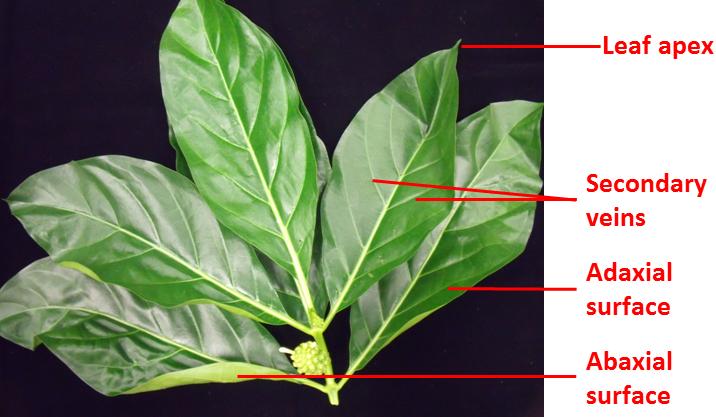
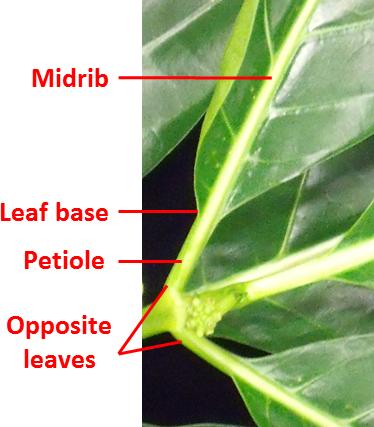
Fig. 18. Leaf morphology of M. citrifolia (Photo: Junhao).

Fig. 19. Abaxial surface of leaf and close-up of domatia in the axil of secondary veins. Note that the domatia is only visible with a light microscope or hand lens (Photo: Junhao).
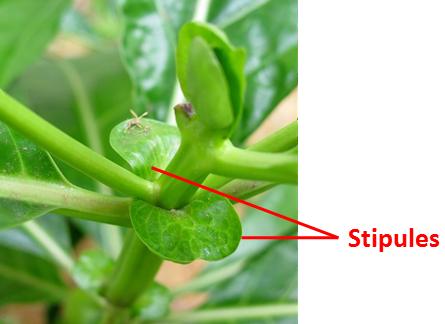
Fig. 20. Interpetiolar stipules of M. citrifolia (© http://floraofsingapore.wordpress.com).
Inflorescences [24][44]
The flowers of M. citrifolia grow in a many-flowered cluster (inflorescence) known as a capitulum (Fig. 21). The inflorescence is terminal although it looks axillary. Recall that the inflorescence of M. citrifolia develops from the terminal bud, not the axillary bud (Fig. 17)! The peduncle (inflorescence stalk) is 4–14 mm long. The capitula are solitary, each 7–20 mm long and 7–15 mm wide, with about 25–60 flowers. However, flowers in the same capitulum open successively over days or weeks. The individual flowers are white, usually have 5 petals each, and are bisexual (Fig. 22).
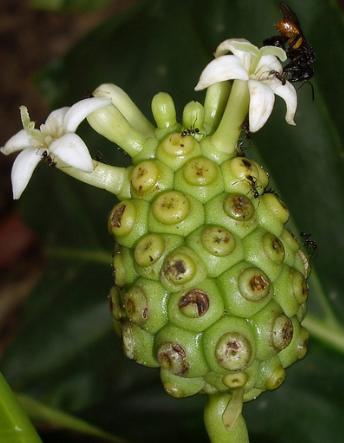 ................
................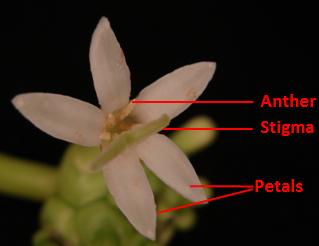
Fig. 21. Capitulum of M. citrifolia (Photo: Ch.Deff). ........ Fig. 22. Flower of M. citrifolia (Photo: Junhao).
The corolla tube is 5–10 mm long, glabrous outside but hairy at the throat inside (Fig. 23). Corolla lobes (petals) are 5.5–7 mm long, 1.7–2.3 mm wide, and are ovate to triangular. The stamens are inserted in or just below the corolla throat. The filaments are 2–3 mm long while the elliptic to oblong anthers are 2–3.5 mm long. The style is 9–12 mm long with bifid green stigma exerted. Each of the fused inferior ovaries has 2 locules, each locule with a solitary ovule.
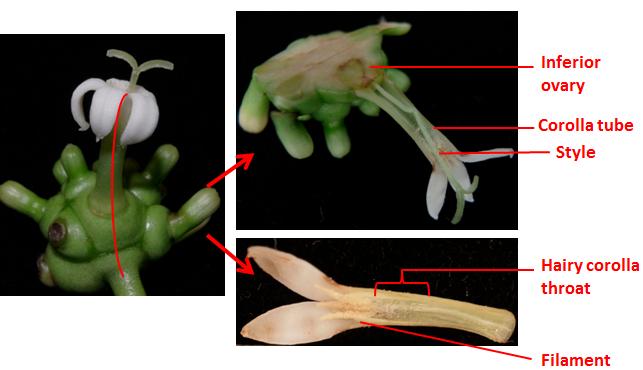
Fig. 23. Dissection of a M. citrifolia flower. The left photo shows the flower before the dissection. The upper right photo shows the female reproductive structures while the bottom right photo shows the male reproductive structures (Photo: Junhao).
Fruits [24][44][47]
The fruits of M. citrifolia are known as drupes. The fruits are fused together into an ovoid multiple fruit (syncarp) which is up to 10 cm in long and up to 6 cm in diameter. Note that each hexagon on the surface outlines the fruit developed from one flower. The syncarp turns from green to translucent yellowish-white colour when fully ripe (Fig. 24). It is soft and fetid when ripe, producing a smell that resembles vomit or rotten cheese.
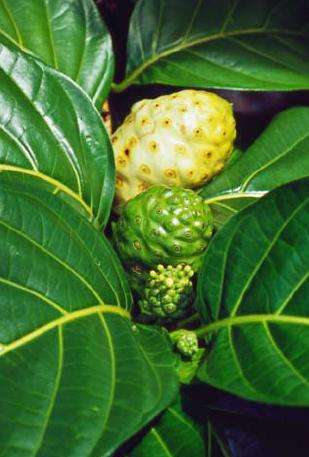
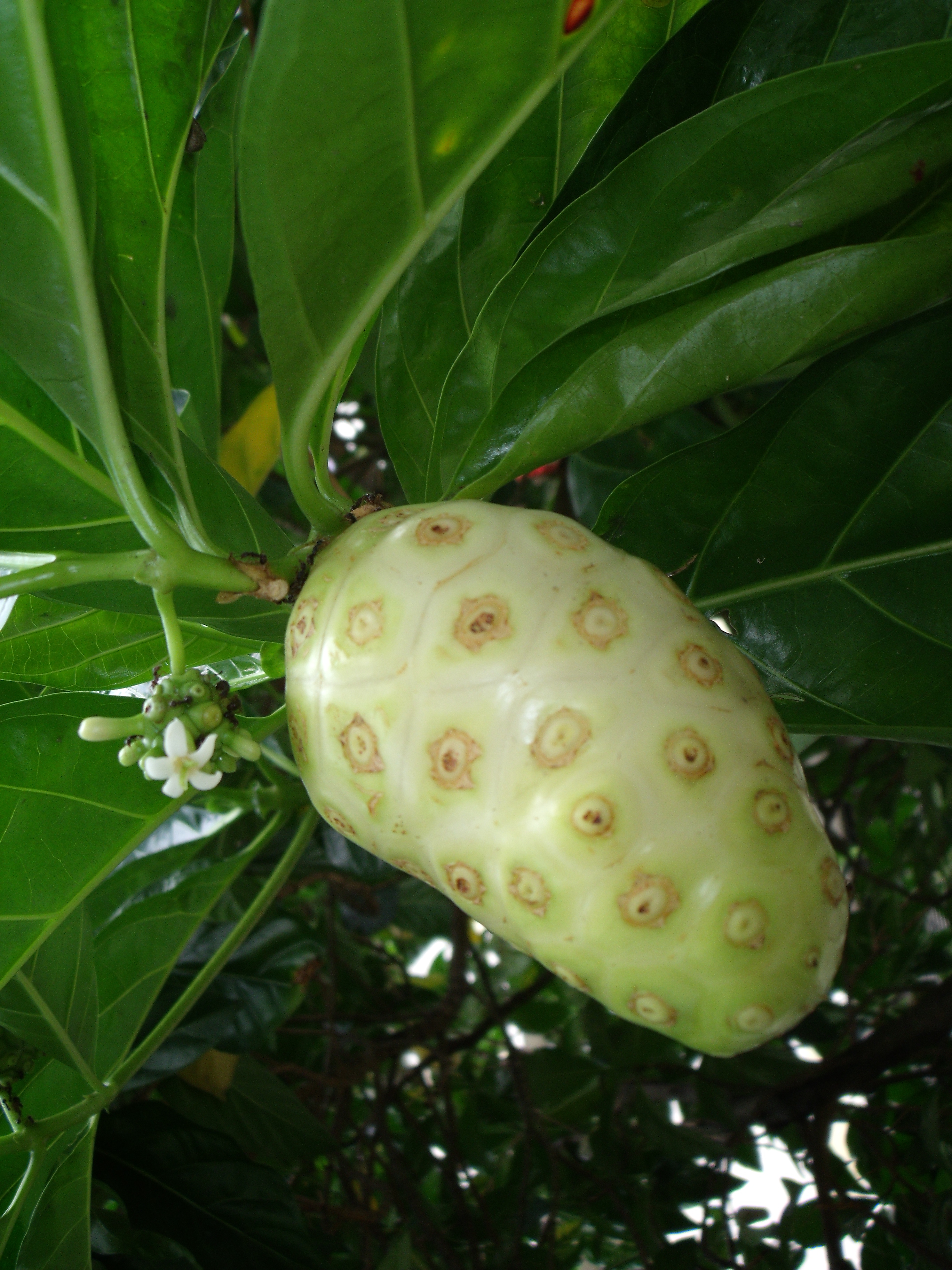
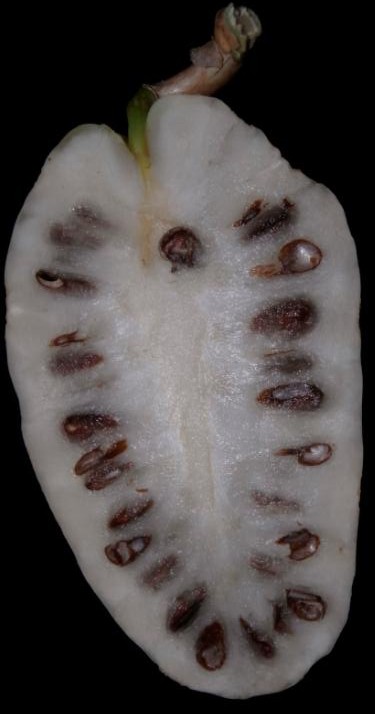
Fig. 24. From left to right, Noni inflorescence/infructescence at different stages of development (Photo: Nelson, 2006), ripe Noni fruit (Photo: Junhao), and cross-section of a Noni fruit (Photo: Junhao).
Seeds [24]
Each seed is fused with a stony endocarp, forming a pyrene. The pyrene is 6.5–7.5 × 4.5–5 × 2.5–4 mm. Each pyrene contains a seed and an air-filled cavity (Fig. 10).
Biology
Natural habitat
M. citrifolia is a eurytopic species i.e., it is able to withstand a wide range of environmental conditions [47]. This hardy plant can thrive in a variety of soil pH and nutrient content [47]. It can inhabit rocky coasts, sea coasts, open grassland, cliffs, salty tide pools, and even lava flows (Fig. 25) [43][47]. In SIngapore, it is naturalized in secondary forests and back mangroves.
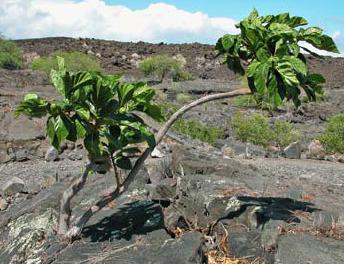
Fig. 25. M. citrifolia growing in a crack in lava rock (Nelson, 2006).
Pollination
Surprisingly, the pollination biology of M. citrifolia has not been studied but it appears that the plants are able to self-pollinate [25][27][47]. Birds and honeybees have been observed to visit the flowers [47][48] and these may be the potential leads that pollination ecologists should follow!
Dispersal
Recall that the pyrenes of M. citrifolia contain an air sac that confer buoyancy (Fig. 10), thus the seeds (which are within the pyrenes) are dispersed by water. The seeds are also dispersed inland by birds and fruit bats [34][49][50]. Refer to How did Noni colonize the tropics?
Ecological interactions
The surface of the Noni capitulum is covered with hexagonal segments that encompass extralfloral nectaries (Fig. 26). These nectaries remain functional during ripening [51]. The weaver ants (Oecophylla smaragdina) and the highly invasive Anoplolepis gracilipes are attracted to these nectaries and they build their nests using the leaves of Noni [52][53]. It is no wonder that virtually every photo of the Noni inflorescence or infructescence is blemished by ants! The ants in turn protect the Noni plant against other herbivores. Recall that the ripe fruits of Noni are toxic to most insects except Drosophila sechellia which exclusively feeds on and breeds in the ripe fruits of Noni! Refer to Is Noni toxic to insects?
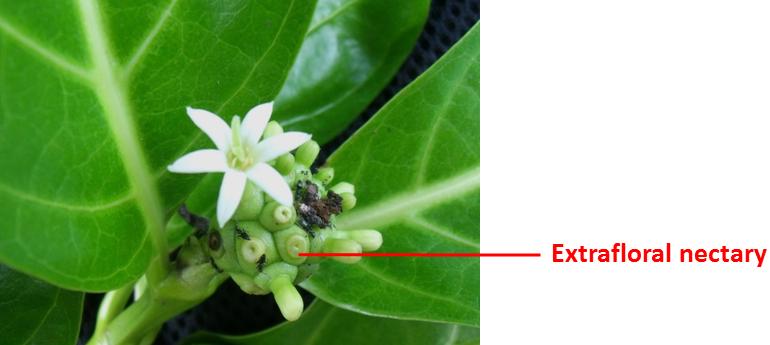
Fig. 26. Extrafloral nectary on the capitulum of of M. citrifolia (Photo: Junhao).
Uses
Traditional medicine
All parts of the Noni plant have been used in traditional medicine. In Malaysia, the ripe multiple fruit is used as a gargle to soothe sore throat [54]. In the Pacific islands, the pounded fruits is used to treat tuberculosis [55]. In the Philippines, fresh fruits are consumed to expel intestinal worms [56]. In Malaysia, the leaves are heated and placed on the abdomen to treat haemorrhage, swollen spleen, and liver diseases [48]. The bark is a strong astringent and is used to alleviate malaria [56]. The root extract is used to relieve hypertension [57] while juice from the flowers is used to soothe sore eyes [58].
Food
In Hawaii, the multiple fruit is eaten during famines [55]. In the pacific islands, the raw or cooked fruit is part of a normal meal [59]. The mature leaves are used to wrap fishes for cooking while the young leaves are eaten as vegetable [60].
Dye
The noni has been famous for its dye which was first used in Europe in 1790 [54]. A red dye is obtained from the bark while a yellow dye is obtained from the roots [45]. They are used to decorate batik cloth in Java [61], and handkerchiefs and turbans in India [62].
Tonic drink
Today, Noni is commercially available as juice, tea, effervescent, or drinks. The juice is claimed to be beneficial in treating atherosclerosis, arthritis, diabetes, high blood pressure, muscle aches and pains, heart disease, AIDS, cancers, gastric ulcers, depression, senility, poor digestion, and drug addiction [8]. Recall that no Noni products have sufficient scientific evidence to be used as medicine presently [8]. Refer to Are Noni products safe and effective?
comments powered by Disqus
References
[1] Dixon A.R., H. McMillen & N.L. Etkin, 1999. Ferment this: the transformation of Noni, a traditional Polynesian medicine (Morinda citrifolia, Rubiaceae). Economic Botany 53, 51–68.
[2] Pawlus A.D. & A.D. Kinghorn, 2007. Review of the ethnobotany, chemistry, biological activity and safety of the botanical dietary supplement Morinda citrifolia (noni). Journal of Pharmacy and Pharmacology, 59(12), 1587–1609.
[3] Elkins R., 2002. The noni revolution: Today's tropical wonder that can battle disease, boost energy and revitalize your health. Woodland Publishing, Utah.
[4] Heinicke R.M., 1985. The pharmacologically active ingredient of noni. Pacific Tropical Botanical Garden Bulletin 15,10–14.
[5] McClatchey W.C., 2002. From Polynesian healers to health food stores: changing perspectives of Morinda citrifolia. Integrative Cancer Therapies 1, 110–120.
[6] Hirazumi A., E. Furusawa, S.C. Chou & Y. Hokama, 1994. Anticancer activity of Morinda citrifolia (noni) on intraperitoneally implanted lewis lung carcinoma in syngeneic mice. Proceedings of the Western Pharmacology Society 37, 145–146.
[7] Furusawa E., A. Hirazumi, S. Story & J. Jensen, 2003. Antitumour potential of a polysaccharide-rich substance from the fruit juice of Morinda citrifolia (noni) on sarcoma 180 ascites tumour in mice. Phytotherapy Research 17: 1158–1164.
[8] Natural Medicines Comprehensive Database Consumer Version [Internet]. Stockton (CA): Therapeutic Research Faculty; ©1995-2012. (reviewed 2011 Dec 27). Available from http://www.nlm.nih.gov/medlineplus/druginfo/natural/758.html.
[9] West B.J., C.J. Jensen, J. Westendorf & L.D. White, 2006. A safety review of noni fruit juice. Journal of food science 71(8), R100–R106.
[10] Stadlbauer V., P. Fickert, C. Lackner, J. Schmerlaib, P. Krisper, M. Trauner & R.E. Stauber, 2005. Hepatotoxicity of Noni juice: report of two cases. World Journal of Gastroenterology 11(30), 4758–4760.
[11] Millonig G., S. Stadlmann S & W. Vogel W, 2005. Herbal hepatotoxicity: acute hepatitis caused by a noni preparation (Morinda citrifolia). European Journal of Gastroenterology & Hepatology 17, 445–447.
[12] Mueller B., M.K. Scott, K. M. Sowinski & K. A. Prag, 2000. Noni juice (Morinda citrifolia): hidden potential for hyperkalemia? American Journal of Kidney Diseases 35(2), 310–312.
[13] Legal L., & M. Plawecki, 1995. Comparative sensitivity of various insects to toxic compounds from Morinda citrifolia (L.). Entomological Problems 26, 155–159.
[14] Legal L., B. Chappe & J. M. Jallon, 1994. Molecular-basis of Morinda citrifolia (L): toxicity on Drosophila. Journal of Chemical Ecology 20, 1931–1943.
[15] R ’Kha S., P. Capy & J.R. David, 1991. Host-plant specialization in the Drosophila melanogaster species complex: a physiological, behavioral, and genetical analysis. Proceedings of the National Academy of Sciences USA 88, 1835–1839.
[16] Louis J. & J.R. David, 1986. Ecological specialization in the Drosophila melanogaster species subgroup: a case study of D. sechellia. Acta oecologica 7, 215–229.
[17] Matsuo T., 2008. Genes for host-plant selection in Drosophila. Journal of Neurogenetics 22, 195–210.
[18] Dworkin I. & C.D. Jones, 2009. Genetic changes accompanying the evolution of host specialization in Drosophila sechellia. Genetics 181, 721–736.
[19] McBride C.S. & J.R. Arguello, 2007. Five Drosophila genomes reveal non-neutral evolution and the signature of host specialization in the chemoreceptor superfamily. Genetics 177, 1395–1416.
[20] Morton J.F., 1992. The ocean-going noni, or Indian mulberry (Morinda citrifolia, Rubiaceae), and some of its ‘‘colorful relatives’’. Economy Botany 46, 241–256. Online PDF.
[21] Whistler W.A., 1985. Traditional and herbal medicine in the Cook Islands. Journal of Ethnopharmacology 13, 239–280.
[22] Abbott I.A., 1992. La’au Hawai’i: traditional Hawaiian uses of plants. Bishop Museum Press, Honolulu.
[23] Singh A.K., K. Singh & P.I. Peter, 2011. Revisiting the origin of the domestication of noni (Morinda citrifolia L.). Plant Genetic Resources 9, 549–556.
[24] Johansson J.T., 1994. The genus Morinda (Morindeae, Rubioideae, Rubiaceae) in New Caledonia: taxonomy and phylogeny. Opera Botanica 122, 1–68.
[25] McClatchey W.C., 2003. Diversity of growth forms, and uses in the Morinda citrifolia L. complex. Proceeding of the 2002 Hawai’i Noni Conference. University of Hawaii, Honolulu. Pp. 5–10.
[26] Razafimandimbison S.G., T.D. McDowell, D.A. Halford & B. Bremer, 2009. Molecular phylogenetics and genetic assessment in the tribe Morindeae (Rubiaceae-Rubioideae): how to circumscribe Morinda L. to be monophyletic? Molecular Phylogenetics and Evolution 52, 879–886. Online PDF.
[27] Razafimandimbison S.G., T.D. McDowell, D.A. Halford & B. Bremer, 2010. Origin of the pantropical and nutriceutical Morinda citrifolia L. (Rubiaceae): Comments on its distribution range and circumscription. Journal of Biogeography 37, 520–529. Online PDF.
[28] Corlett, R.T., 1988. The naturalized flora of Singapore. Journal of Biogeography, 15(4): 657–663.
[29] Keng, H., 1990. The Concise Flora of Singapore: Gymnosperms and Dicotyledons. Singapore University Press, Singapore.
[30] Ridley, H.N., 1922–25. The flora of the Malay Peninsula, Vols. 1–5. Reeve & Co., London.
[31] Ng, P.K.L. & Y.C. Wee, 1994. The Singapore Red Data Book: Threatened plants and animals of Singapore. Nature Society (Singapore), Singapore.
[32] Davison, G.W.H., P.K.L. Ng & H.C. Ho, 2008. The Singapore Red Data Book. 2nd ed. The Nature Society (Singapore), Singapore.
[33] Chong, K.Y., H.T.W. Tan & R.T. Corlett, 2009. A checklist of the total vascular plant flora of Singapore: native, naturalised and cultivated species. Raffles Museum of Biodiversity Research, National University of Singapore, Singapore. Online PDF.
[34] Guppy H.B., 1917. Plants, seeds and currents in the West Indies and Azores. Williams & Norgate, London.
[35] Hayden M.V. & J.D. Dwyer, 1969. Seed morphology in the tribe Morindeae (Rubiaceae). Bulletin of the Torrey Botanical Club 96, 704–710.[36] Razafimandimbison S.G., S. Ekman, T.D. McDowell & B. Bremer, 2012. Evolution of growth habit, inflorescence architecture, flower size, and fruit type in Rubiaceae: Its ecological and evolutionary implications. PloS one 7(7), e40851. OnlinePDF.[37] Simpson M.G., 2010. Plant Systematics. Elsevier, Amsterdam.
[38] Razafimandimbison S.G., D.A. Halford, T.D. McDowell & B. Bremer, 2011. Proposal to conserve the name Morinda citrifolia (Rubiaceae) with a conserved type. Taxon 60(2), 607. Online PDF.
[39] Dwyer J.D., 1980. Rubiaceae – Part II. In: Woodson R.E. & R.W. Schery. Flora of Panama. Part IX. Annals of the Missouri Botanical Garden 67(2), 257–522.
[40] McClatchey W.C., 2002. From Polynesian healers to health food stores: changing perspectives of Morinda citrifolia. Integrative Cancer Therapies 1, 110–210.
[41] Applequist W. L., 2012. Report of the nomenclature committee for vascular plants: 64. Taxon, 61(5), 1108–1117.
[42] Razafimandimbison S.G & B. Bremer, 2011. Nomenclatural changes and taxonomic notes in the tribe Morindeae (Rubiaceae). Adansonia 33, 281–307.
[43] Corner E.J.H., 1988. Wayside Trees of Malaya. The Malayan Nature Society, Kuala Lumpur, Malaysia.
[44] Wong, K. M., 1989. Rubiaceae. In: Ng, F.S.P. (ed.), Tree Flora of Malaya 4. Longman, Malaysia. Pp. 324–425.
[45] Puff C., K. Chayamarit & V. Chamchumroon, 2005. Rubiaceae of Thailand: A pictorial guide to indigenous and cultivated genera. Forest Herbarium, Bankok.
[46] Wong K.M., 1984. A synopsis of Morinda (Rubiaceae) in the Malay Peninsula, with two new species. Malayan Nature Journal 38, 89–98.
[47] Nelson S.C. & C. Elevitch, 2006. Noni: the complete guide for consumers and growers. Permanent Agriculture Resources, Hawaii.
[48] Abe T., 2006. Threatened pollination systems in native flora of the Ogasawara (Bonin) Islands. Annals of Botany 98, 317–334.
[49] Whittaker R.J. & S.H. Jones, 1994. The role of frugivorous bats and birds in the rebuilding of a tropical forest ecosystem, Krakatau, Indonesia. Journal of Biogeography 21, 689–702.
[50] Shilton L., 1997. Seed dispersal by fruit bats on the Krakatau Islands, Indonesia. Australian Bat Society Newsletter 8, 6–13.[51] Keller K. H., 1985. Extrafloral nectaries on plants in communities without ants: Hawaii. Oikos 44: 407–414.[52] Lim G.T., L.G. Kirton, S.M. Salom, L.T. Kok, R.D. Fell & D.G. Pfeiffer, 2008. Mahogany shoot borer control in Malaysia and prospects for biocontrol using weaver ants. Journal of Tropical Forest Science 20(3), 147–155.[53] Savage A. M.,J.A. Rudgers & K.D. Whitney, 2009. Elevated dominance of extrafloral nectary-bearing plants is associated with increased abundances of an invasive ant and reduced native ant richness. Diversity and Distributions 15, 751–761.[54] Burkill I.H., 1935. Dictionary of the economic products of the Malay Peninsula. Crown Agents for the Colonies, London.[55] Degener O., 1945. Plants of the Hawaii National Park illustrative of plants and customs of the South Seas. New York Botanical Garden, New York.[56] Quisumbing E., 1951. Medicinal plants of the Philippines. Technical Bulletin 16. Philippine Department of Agriculture & Nature Reserves, Manila.[57] Martin M.A., 1971. Introductional' ethnobotanique du Cambodge. Centre National de la Recherche Scientifique, Paris.[58] Christopherson E., 1935. Flowering plants of Samoa. Bulletin 128. Bernice Pauahi Bishop Museum, Honolulu, Hawaii.[59] Brown F.B.H., 1935. Flora of southeastern Polynesia III. Dicotyledons. Bulletin 130. Bernice Pauahi Bishop Museum, Honolulu, Hawaii.[60] Pongpangan S. & S. Poobrasert, 1972. Edible and poisonous plants of Thai forests. Science Society of Thailand, Bangkok.[61] Cribb A.B. & J.W. Cribb, 1975. Wild foods in Australia. William Collins, Sydney, Australia.[62] Drury H., 1873. The useful plants of India. 2nd ed. William H. Allen & Co., London.